The basic goal of classic fraud is to make money. Since it's just a money game, I think it's also the least dangerous. After all, the medical humbugs, for instance, take your money and your health. But that's not to be taken as justification. People lose a lot of money to these people all the time. It's VERY dangerous.
I'm going to teach you a few classic cons. In so doing, you're going to learn some important principles to protect yourself against others.
Three Card Monte
Who hasn't seen the Three Card Monte at some point? Images of men shuffling three cards around for a bet are commonplace. What is somewhat less commonplace is the knowledge that it can't be beat. And indeed, it's true. There is no way to beat the Three Card Monte, if the con-man knows what he's doing.
First, I'm going to teach you the basic move that wins most of the games. Then we'll get into a few other "cheats." I'm afraid I do have to betray a secret of magic for this, but I feel justified in doing so because people lose so much money at this game (besides, magicians are doing the Two Card Monte nowadays, anyway).
The Three Card Monte looks something like this. Three cards, folded so you can pick them up and shuffle them around easily. The goal is to keep track of a particular card, usually a queen, and bet money on where it is. But the first rule of con games is that the con artist always wins, except when he intentionally loses.
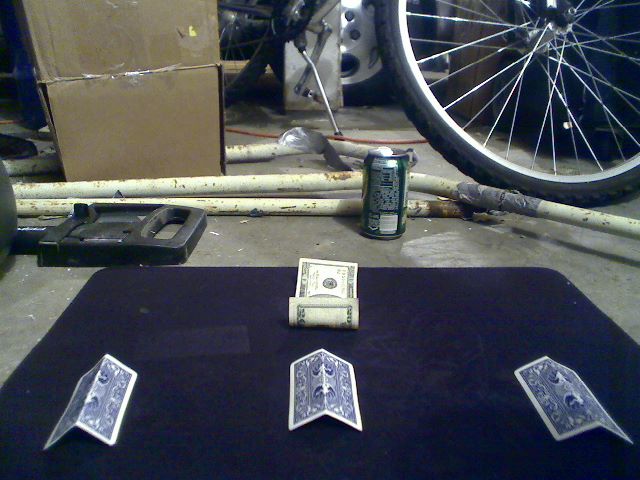
For this illustration, I've chosen two black cards (a nine and a three) and a red queen.
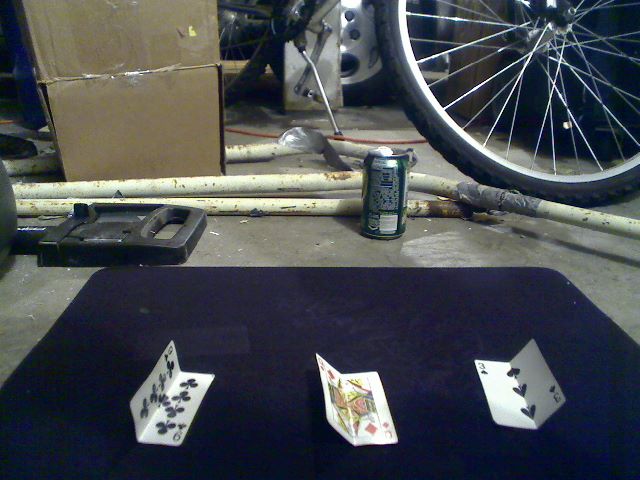
Remember, this is the position the cards start in, with the queen in the middle. They will, however, be face down. The con artist will show you where the queen is, and then shuffle the cards around. You should be able to keep track of the queen if you keep your eye on it. That's not too hard.
However, this isn't a fair game. There's a special move the con man will do. Each individual has a move he likes to do, but in any case, the cards get switched without you knowing it. I'll teach you one of the moves I know.
Bring the queen to the middle. Which card is on either side doesn't matter, as long as the queen's in the middle. Pick up the card to your right side (in this case, it's the three), with your thumb and middle finger.
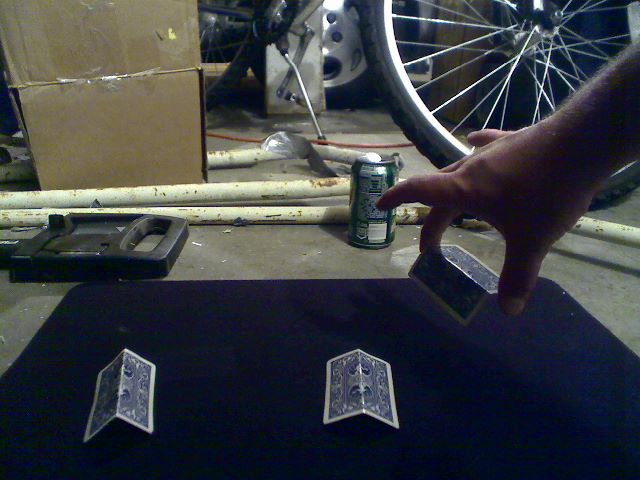
Grab the queen between the thumb and the next finger over.
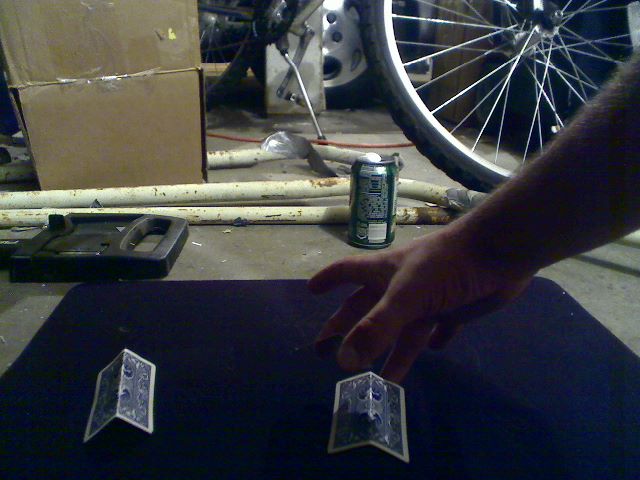
You're now holding two cards. The thumb holds one end of each, and each of the two fingers holds a card.
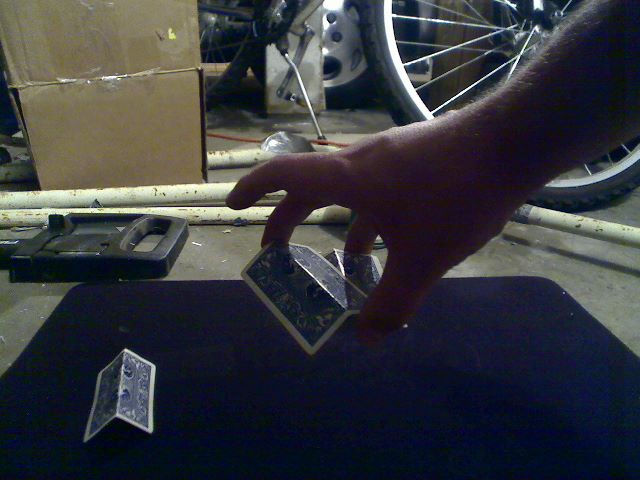
Remember, the queen is the card on the bottom. The three is the card on top. The middle finger is on the three.
Next, you throw down one of the cards.
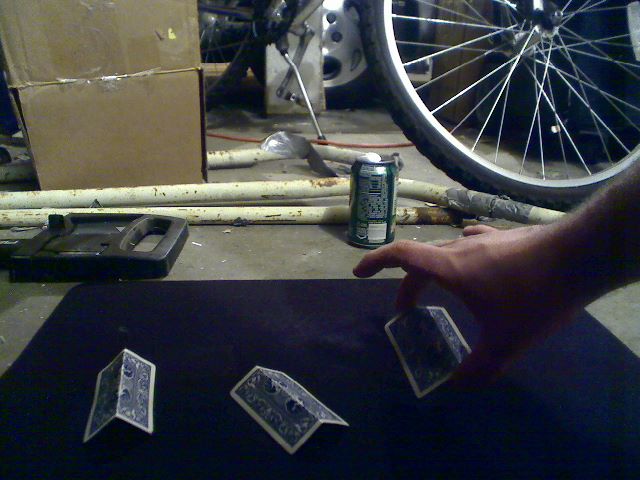
Which card did I just throw down? The bottom one, right? It's the easiest to drop, and I've still got the top one by the middle finger.
So if I put that card down, you'd probably bet on the middle card. Obviously, that's the queen, right?
WRONG! It's a trick!
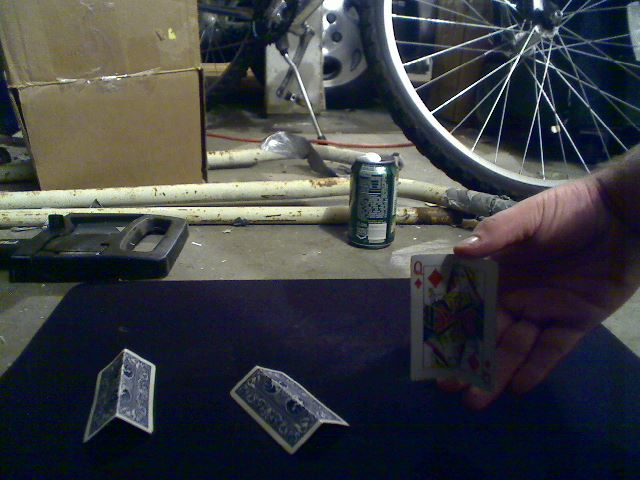
When I threw down the card, I didn't throw down the bottom card. I threw down the top card (the three), and quickly moved my middle finger to the other card so it was in the same place. I dropped the top card, but it looked like I dropped the bottom card.
The move is as simple as that. The con is a bit more difficult. If the con-man always wins, no one will keep playing. Yet if he loses, he won't be making any money. Thus, he usually has an accomplice in the crowd. Using hand signals, he'll tell the accomplice where to bet. Sometimes the accomplice will win, sometimes he'll lose. But it will help create the illusion that this is a beatable game when in fact it isn't.
The con-man also won't allow winning bets from the crowd. If they want to bet on the right card, he'll tip off his accomplice to bet even higher on the wrong card. The con-man only takes one bet at a time, and he'll always take the higher bet. If someone keeps raising the amount, he'll tip off his accomplice to get angry and kick the game over. Anything to keep a sucker from winning.
So a word to the wise: don't play the Three Card Monte.
Now, there are a couple of important principles we need to add to our toolkits.
First, the game will seem fair, but the con-man always wins.
Second, the con-man will often cheat using sleight of hand (though some cons are purely psychological) to throw off the mark.
Third, just because someone appears to be an innocent bystander or fellow participant, it isn't necessarily so. If there's money involved, be cautious of all strangers, no matter what position they're in. Con-men often use an accomplice to make the game seem fair or provide misdirection.
Change Raising
This is a classic money con. There's only one "move" and it's easy. The con-man has a lot of misdirection to work with.
The basic con is this. The con-man goes up to a clerk in a store with some money and asks to trade it for different denominations. But he confuses the clerk and walks away with more money than he deserves. There are several methods. I'll teach you one of the simple ones.
Walk up to a clerk, preferably in a busy store so they'll be in a hurry. Ask for a ten for ten singles. They agree and hand you a ten. You hand them a stack of money and tell them to count it, just to make sure you gave them the right amount.
While they're counting the money, you pocket the ten they just gave you. They discover you don't have ten ones. You have nine ones and a ten, and tell you so.
Act confused for a minute. Make them repeat once or twice, but don't over do it. You're trying to confuse them, but not make them suspicious.
They might ask if you have another single and ask if you'd rather have a twenty instead. If they don't, that's okay. Just make the offer yourself. Say: "Hang on a minute. I think I have another single. Can I get twenty?"
You pull the single out of the pocket and add it to the stack. There's twenty dollars there, so they hand you a twenty. Then you thank them and make a quick getaway.
You see, because you threw the amount in question out of balance and quickly hid the first ten, they've given you thirty dollars. You've only given them twenty. That's the con.
The basic lesson to be learned here is that if you're getting confused, slow it down. Don't let anyone go to fast for you. If possible, keep all the money in question visible the whole time. If not, make sure you notice what goes where and don't forget. Otherwise, you might end up a few dollars short.
Pigeon Drop
The Pigeon Drop is one of the oldest cons in the book, but it's still effective because it plays to very basic aspects of human psychology. If you don't know what you're looking for, a smooth operator can catch you off guard and take you for tons of money.
To pull this con off, you need several things. You need a wallet (make sure there are no identity cards or anything with a name or address on it). You need a lot of cash. The amounts range from several hundred dollars to several thousand dollars. Just make sure it's a lot of money, because it needs to catch the mark's eye. You need two identical envelopes. You need newspaper clippings, cut to the size of money (and about the same thickness as your stack of real money). And you need an accomplice.
The set-up goes like this. Put all the money in the wallet. Again, make sure the wallet doesn't have anything that can be used to identify the owner. Put the newspaper clippings in one of the envelopes and seal it.
Take the wallet, but give your accomplice the two envelopes. One is empty and unsealed. The other is full of newspaper clippings.
Your accomplice then hits the streets. You're not with him, but you're close by and watching. He's going to try and get into a conversation with people on the street. He can ask for directions, or ask for tips on a good place to eat. Whatever. But he needs to get caught up in conversation with the potential mark. Once he's gotten the person to stick around long enough that you're confident he won't just walk away, the potential mark is promoted to the mark.
You walk up with the wallet. As you walk past them, you bend down and "pick up" the wallet, as if you just found it on the street. Ask the two people if one of them lost it. They'll both answer no.
Your accomplice (or "inside man") is going to play along for certain. That's what you've agreed on. The mark likely will, too. Act it out casually. You're just three guys who've found a wallet. None of you know each other. At some point, open it up to see what's in there. Maybe looking for an ID card. "Find" the money and pull it out.
At this point, everyone needs to act surprised at the amount of money. Pull the money out. Say: "Holy shit, this looks three thousand dollars." Whatever amount you actually say should be close to the amount in the wallet, but don't feel the need to be too precise.
You suggest that the three of you should split the money. Meanwhile, your inside man puts it in an envelope and seals it for safe keeping. While you keep the mark talking, he switches the envelope for the one full of newspaper clippings.
Now comes the moment of truth. You offer to take the wallet inside the nearest building and see if someone's reported it missing and turn it in to lost and found. Ask to take the money with you.
At this point, the mark should protest. He won't trust you that much. Not when there's a thousand dollars at stake. If he doesn't, your accomplice will. So you don't get to take the money with you.
Manipulate the conversation. Get the mark to hold onto the envelope with what he thinks is all the money. This will make him feel more secure about it. Then you need to protest that the mark and your accomplice can run away while you're inside, so you want something from them. The accomplice offers some of his own money. Fifty to a couple hundred dollars, say.
Get the mark to do the same. He'll give you some of his own money. The justification is that, though he's insecure about giving someone money, it's only a hundred dollars or so, while he's holding three thousand.
You take the money and leave. Go inside the building so he's not suspicious. You can come out a different door and make a clean getaway. Promise them that you'll be back in five minutes.
The accomplice will carry on talking to the mark for those five minutes, continuing to ask directions perhaps. Eventually, the accomplice says, "Don't go anywhere. I'm going to go inside and find him."
Now the accomplice makes a clean getaway, too. The mark is left stranded, but he thinks he's still holding three thousand dollars. Eventually, he'll look and realize it's just newspaper clippings, but by then you'll be long gone.
The psychology of this one is pretty simple. It plays off of human emotion and basic psychological traits.
When there's this much money involved, people are less likely to think things through clearly. You need to make sure you're always thinking, even in such an emotional situation. If you stand to gain a lot of money or lose a lot of money, that's precisely the time you need to hold onto that critical thinking, not lose it.
Then there's the pack mentality. Here are two people who apparently don't know each other, coming up with the same idea at the same time. If you're not careful, you might get caught up in that and lose a lot of money. Even if they don't seem to know each other, you need to think for yourself. Don't let the majority rule your life. The majority can be wrong.
Also, people tend to be very trusting. I think that's great, but it can also get you into trouble. It's not uncommon for people, though they know rationally that there are bad people, to think that everyone they happen to encounter is just as honest as them. I agree with being trusting, but there's such a thing as being too trusting. It sickens me to have to say it, but sometimes, our fellow man will try to hurt us.
While I was discussing cons with someone, he said: "That's a lot of effort just to get someone's money. Why not just corner him and take it from him?"
There's a degree of validity to that statement. You need to watch for physical force, too. But there's a big difference, and there are very good reasons why people use cons instead of physical force.
Physical force is obvious. If you're taking someone's wallet from him physically, you're either threatening him or incapacitating him and then taking it (there's also the pickpocket, but that's something of a cross between force and a con in that it's forceful but just as deceptive as the con). That's the first reason people use the con instead: they prefer to be more subtle, possibly for personal safety reasons. A mark could have a gun. If you con him, you're gone before he even thinks to use it. If you try to take it by force, you get shot.
Some people also lack the physical strength for force, but have the charisma and skill necessary to pull off a con. Though I'm an honest person, I place myself in that category. I could pull off the con, but I couldn't beat someone up.
There's also a moral element. Though the con artist is a thief, he's usually not going to go as far as assault or murder. It's all immoral, but to different degrees.
So the basic lesson is: think things through. Don't let people go too
fast for you. If it seems like it's too good to be true, it probably is.
And always make sure you know exactly what's going on.